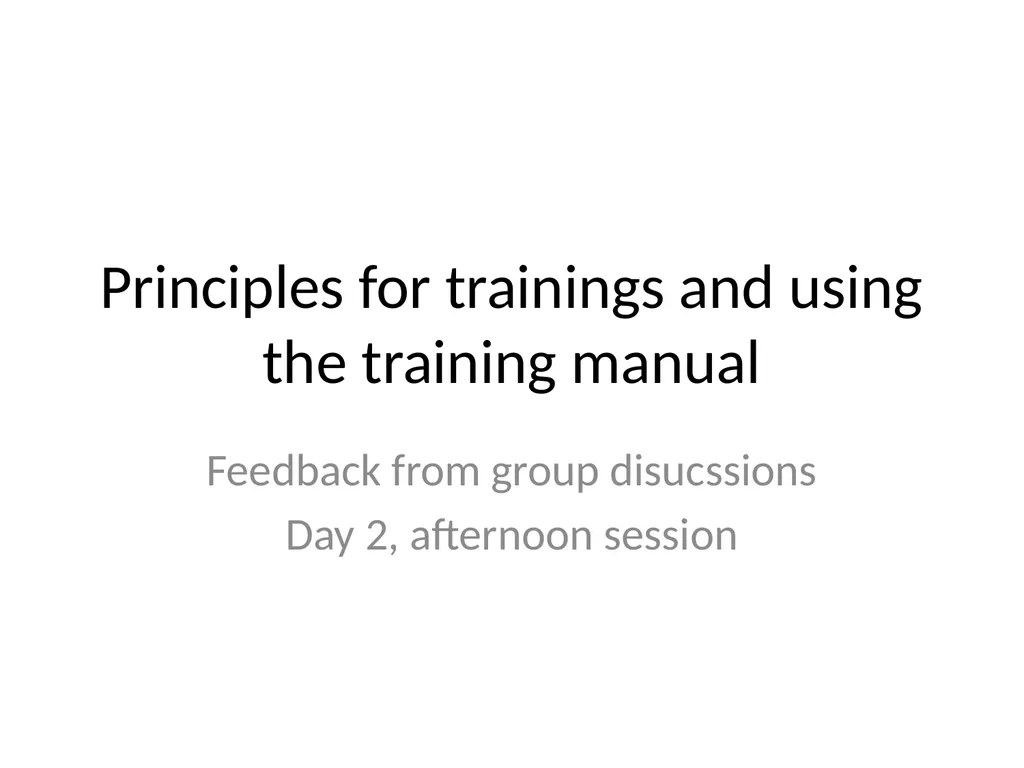Principles for trainings and using the training
Author : pamella-moone | Published Date : 2025-05-29
Description: Principles for trainings and using the training manual Feedback from group disucssions Day 2 afternoon session Key challenges Group 1 Principles for trainings and using the training manual HiAP terminology Capturing relevant target
Presentation Embed Code
Download Presentation
Download
Presentation The PPT/PDF document
"Principles for trainings and using the training" is the property of its rightful owner.
Permission is granted to download and print the materials on this website for personal, non-commercial use only,
and to display it on your personal computer provided you do not modify the materials and that you retain all
copyright notices contained in the materials. By downloading content from our website, you accept the terms of
this agreement.
Transcript:Principles for trainings and using the training:
Principles for trainings and using the training manual Feedback from group disucssions Day 2, afternoon session Key challenges – Group 1 Principles for trainings and using the training manual HiAP terminology Capturing relevant target audience Representatives from units/sectors can be lonely if they trained alone. Therefore may wish to find resources to have more than one person per stakeholder group. Also may address high-turnover of staff and loss of investment. Weak structures Attracting other sectors and be multidisciplinary Low investment in mid-career training Case studies specific to the country context Key challenges – Group 2 Identifying issue of mutual strategic interest Resources – Conducting stakeholder mapping Knowing about priorities of relevant sectors Training team Resources – identifying champions Skills, experience and interdisciplinary team members Target audience Resources – identifying relevant trainers Get buy-in from policy makers to facilitate engagement of technical staff Technocrats remain despite political changes Stakeholders, including NGOs, private sector Description/frameing of training Key challenges – Group 3 Target audience – to trainers or actors Resistance to something new Not to repeat, go into unnecessary detail Importance of having ice-breakers Encourage linkages with previous experiences and expertise Lack of information on context or participants National, regional and local champions/informants Lack of resources E.g. UN, UNCT, private sector, In kind support as well as financial support New, innovative resource sources Trainer must really have HiAP skills, knowledge, experiences. Be able to field and respond to difficult questions. Key challenges – Group 4 Lack of interest People getting trained being lonely when go back to country context Lack of authority secure from higher levels Choice and level of influence of participants Human resources develop small pool of people to train and facilitate issues Key challenges – Group 5 Champion at national, regional and local level Context and power Decentralised --- centralised National --- regional --- local Urban --- rural Universal --- individual values and coverage Public --- private Data, case studies, examples relevant to audience Non-health professionals and sectors (need basic level of health literacy, acronyms, etc) Resources Advocates and leaders (in/out health, in/out system) Case studies, information quality control needed Pilot and testing and lessons learned How to use social networks and other networks (WHO, UN, mayors, parliamentary unions, civil society and NGOs, interest groups) Collaborative platform – need combination of online, face-to-face, etc. Practical next steps USB stick/CD/platform of all resources referenced in manual Translation














